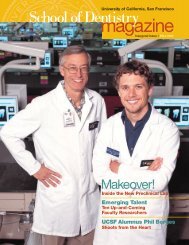Acknowledgements - UCSF School of Dentistry - University of ...
Acknowledgements - UCSF School of Dentistry - University of ...
Acknowledgements - UCSF School of Dentistry - University of ...
You also want an ePaper? Increase the reach of your titles
YUMPU automatically turns print PDFs into web optimized ePapers that Google loves.
Methods: Non-stable fractures were created mid-diaphysis in the murine tibia and administered an injection <strong>of</strong> murine-derived<br />
TSCs expressing enhanced Green Fluorescent Protein (eGFP) or a control media. Bone healing and vascularity were analyzed<br />
histologically on days 5, 7, 14, 21.<br />
Results: Preliminary data suggests that TSCs may promote vascular remodeling during the early phases <strong>of</strong> fracture repair as<br />
evident from blood islands near the fracture site at day 5 that resemble those seen in the placenta. Furthermore, TSC injected mice<br />
reveal a fracture callus predominately composed <strong>of</strong> bone at day 14, compared to controls containing both cartilage and bone.<br />
Conclusions: This evidence suggests that a local injection <strong>of</strong> TSCs at a non-stable fracture may remodel the local vasculature and<br />
enhance the rate <strong>of</strong> fracture repair by increasing blood supply. Alternatively the TSCs may have accelerated bone regeneration by<br />
providing trophic cytokines at the fracture. Further experiments are aimed at determining the specific mechanism by which TSCs<br />
contribute to vascular remodel ing and enhanced osteo-regeneration.<br />
Support: This project was supported by NIH/NCRR/OD <strong>UCSF</strong>-CTSI Grant Number TL1 RR024129. Its contents are solely the<br />
responsibility <strong>of</strong> the authors and do not necessarily represent the <strong>of</strong>ficial views <strong>of</strong> the NIH.<br />
#24 Title: Role <strong>of</strong> Nance-Horan Syndrome protein in epithelial morphogenesis<br />
R SARMICANIC (1), T WITTMANN (2), P KUMAR (2)<br />
(1) <strong>UCSF</strong> <strong>School</strong> <strong>of</strong> <strong>Dentistry</strong>, (2) <strong>UCSF</strong> Department <strong>of</strong> Cell and Tissue Biology<br />
Introduction: Null mutations in the NHS gene cause an X-linked genetic disorder, Nance-Horan Syndrome that is characterized by<br />
congenital cataract, dental abnormalities, and in few cases, mental retardation. Many <strong>of</strong> these phenotypes could be explained by<br />
defects in epithelial morphogenesis. NHS has been proposed to interact with the tight junction protein ZO-1 and regulate actin<br />
dynamics through an N-terminal WAVE domain. However, the function <strong>of</strong> NHS during epithelial morphogenesis or remodeling is<br />
unknown.<br />
Objective: To begin to understand NHS function in epithelial cells, the current study examined the localization and dynamics <strong>of</strong> full<br />
length NHS protein in a 3D epithelial cell culture model.<br />
Methods: An MDCK cell line stably expressing EGFP-NHS was generated, and EGFP-NHS dynamics were investigated by live cell<br />
spinning disk confocal microscopy in 3D cell culture in which MDCK cells form apical-basal polarized, spherical cysts. Fluorescence<br />
Recovery Afte r Photobleaching (FRAP) was used to determine the NHS turnover at cell-cell junctions.<br />
Results: EGFP-NHS localized to lateral cell-cell contacts in polarized epithelial cells, but was absent from the basal or apical cell<br />
surfaces. EGFP-NHS localization was distinctly different from ZO-1. This was different from previously reported colocalization <strong>of</strong><br />
ZO-1 and NHS, and indicates that NHS is not involved in tight junction formation. However, EGFP-NHS partially co-localized with<br />
actin cables that run laterally between polarized epithelial cells. NHS turnover at cell-cell junctions was measured to have an<br />
average t1/2 <strong>of</strong> 6.7±1.8s. This time was faster than t1/2 <strong>of</strong> 119±21s; the recovery time previously reported for ZO-1. The recovery<br />
time for NHS further indicated that NHS is not a tight junction protein.<br />
Conclusion: Our results support the hypothesis that NHS is an integral part <strong>of</strong> cell-cell contacts in polarized epithelial cells, where it<br />
may regulate circumferentia l actin polymerization dynamics.<br />
Support: American Associate <strong>of</strong> Dental Research (AADR) Student Research Fellowship and support from Delta Dental <strong>of</strong> California<br />
#25 Title: The Role <strong>of</strong> NMHCIIA in Fusion <strong>of</strong> the Secondary Palate<br />
V SINGH (1) J BUSH (2)<br />
(1) <strong>UCSF</strong> <strong>School</strong> <strong>of</strong> <strong>Dentistry</strong>, (2) <strong>UCSF</strong> Department <strong>of</strong> Cell and Tissue Biology and the Program in Crani<strong>of</strong>acial and Mesenchymal<br />
Biology<br />
Introduction: Non-syndromic cleft palate is a common crani<strong>of</strong>acial anomaly, occurring in about 1/1000 births worldwide. Disruption<br />
in elevation, attachment, or fusion <strong>of</strong> secondary palatal shelves during development can cause clefts, but the molecular effectors <strong>of</strong><br />
this morphogenesis remain unclear. Gene association studies have identified MYH9, encoding the heavy chain <strong>of</strong> non-muscle<br />
myosin-IIA (NMHCIIA), as a candidate in non-syndromic clefting. Since non-muscle myosin-II (NMII) functions in numerous cell<br />
biological processes including cell migration, adhesion, and cytokinesis, we sought to pinpoint the role <strong>of</strong> NMHCIIA in<br />
palatogenesis.<br />
Objectives: To examine the role <strong>of</strong> NMII in palatal shelf fusion by expression analysis and functional approaches.<br />
Methods: Expression analysis was performed on mouse embryo sections at embryonic day 13.5 (E13.5) and 14.5 (E14.5) using insitu<br />
hybridization (ISH) and immuno-fluorescence following standard protocols. For functional analysis, palatal shelves were<br />
dissected at E13.5 and placed in BGjb medium containing DMSO control or 10μM blebbistatin (an inhibitor <strong>of</strong> NMII) in DMSO at<br />
37°C/5% CO2 (96hrs). After coronal sectioning (7μm) and hematoxylin/eosin staining, palatal fusion was quantified by mean fusion<br />
score (MFS).<br />
Results: ISH and immuno-fluorescence analysis revealed elevated expression <strong>of</strong> NMHCIIA in medial edge epithelium during fusion.<br />
MFS suggested partial fusion(5/7) and nonfusion(2/7) for palatal shelves cultured in blebbistatin medium(n1=7). Shelves in DMSO<br />
medium(n2=8) showed partial fusion(3/8) and complete fusion(5/8) using MFS. Differences in fusion between two conditions were<br />
significant by Mann-Whitney U-test (p




